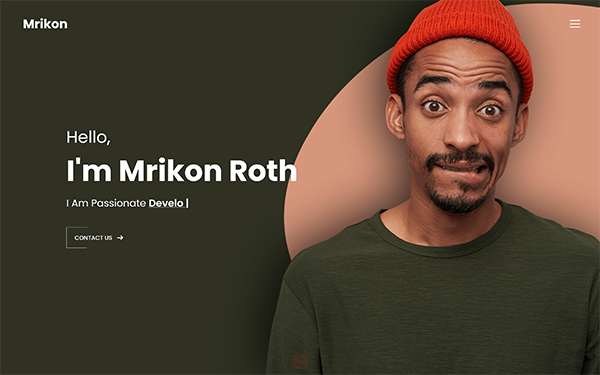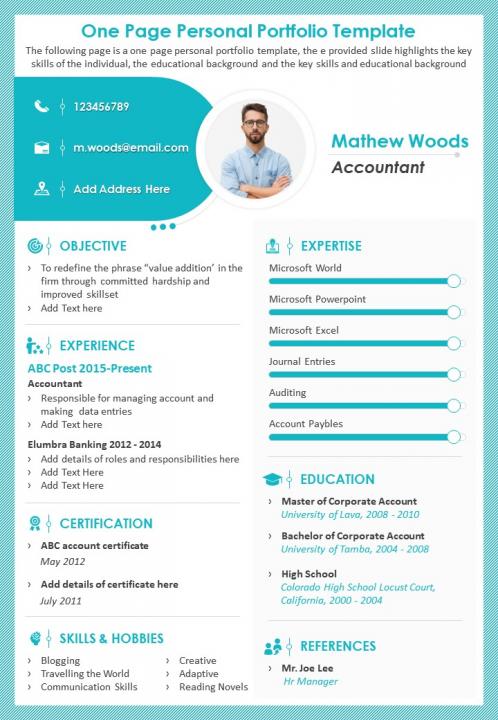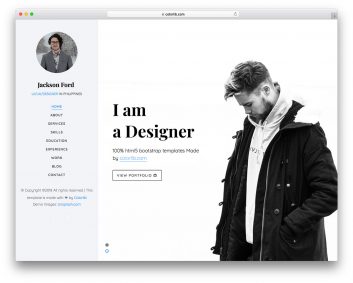If you’re looking for a way to showcase your skills and projects online, then the “Personal portfolio template” is just what you need. With Systeme.io, you have access to an all-in-one platform that simplifies running your online business. From email marketing and sales funnels to webinars and online course management, Systeme.io has got you covered. Plus, with its free plan and affordable pricing options, you can get the best value for your money. So why wait? Start building your personal portfolio today and take your online presence to the next level.

This image is property of d85wutc1n854v.cloudfront.net.
Understanding the Importance of a Personal Portfolio
Whether you’re a freelancer, an entrepreneur, or a job seeker, having a personal portfolio is essential in showcasing your skills, experiences, and achievements. It serves as a comprehensive representation of your professional journey and capabilities, allowing potential clients, employers, or collaborators to gain insight into your work. In this article, we will explore why you need a personal portfolio, how it impacts your professional image, and the role it plays in showcasing your skills and experiences.
Why you need a personal portfolio
Having a personal portfolio is no longer an option but a necessity in today’s competitive professional landscape. It allows you to stand out from the crowd by providing tangible evidence of your abilities and accomplishments. Instead of relying solely on a resume or CV, a personal portfolio allows you to showcase your work in a visual and interactive manner, creating a lasting impression on anyone who views it. It gives potential clients or employers a deeper understanding of your skills, creativity, and expertise, ultimately increasing your chances of securing new opportunities.
How a portfolio impacts your professional image
Your professional image is crucial in building credibility and trust in the eyes of clients, employers, or collaborators. A well-curated personal portfolio demonstrates your professionalism, attention to detail, and dedication to your craft. It showcases your ability to deliver high-quality work and effectively communicate your ideas. By presenting a portfolio that highlights your past projects, clients can see firsthand the value you bring to the table, giving them confidence in your capabilities and increasing your chances of landing new projects or job opportunities.
The role of a portfolio in showcasing your skills and experiences
A personal portfolio serves as a medium through which you can effectively communicate your skills, experiences, and accomplishments to potential clients or employers. It allows you to showcase the breadth and depth of your expertise, highlighting specific projects or achievements that align with the requirements of a particular opportunity. By including samples of your past work, testimonials, and references, you can provide concrete evidence of your abilities and demonstrate your unique approach to problem-solving. A personal portfolio helps you differentiate yourself from others in your field, ultimately positioning you as a competent and valuable professional.

This image is property of www.slideteam.net.
Basic Elements of a Personal Portfolio Template
When creating a personal portfolio, it’s important to include the essential elements that effectively represent your professional journey. Here are some key components to consider when designing your personal portfolio template:
Your professional summary
Your professional summary is the first section of your portfolio that potential clients or employers will see. It should be concise, compelling, and give a clear overview of your skills, experiences, and areas of expertise. Use this section to capture the reader’s attention and entice them to explore further.
Detailed work experience
In this section, include a comprehensive list of your previous work experiences. Highlight key responsibilities, achievements, and projects you have undertaken. It’s important to be specific and provide examples of how your work has positively impacted previous clients or employers.
Skills and abilities section
List your core skills and abilities that are relevant to your profession. Be sure to mention both hard skills (technical skills specific to your industry) and soft skills (traits and characteristics related to teamwork, communication, or problem-solving). Highlight any certifications or training you have obtained.
Education and credentials
Include your educational background and any relevant credentials or certifications you have acquired. Mention any degrees, diplomas, or courses completed that are directly related to your industry. This section helps establish your qualifications and expertise in your field.
Portfolio or project samples
Arguably the most important section of your personal portfolio, this is where you showcase your best work. Include samples of projects that highlight your skills, creativity, and problem-solving abilities. Make sure the samples are diversified and demonstrate your range of capabilities.
Testimonials and references
Add testimonials or references from previous clients or employers who can vouch for your professionalism and quality of work. These testimonials help build trust and credibility in your abilities and provide additional evidence of your skills and capabilities.
Choosing the Right Format for Your Personal Portfolio
Choosing the right format for your personal portfolio depends on your preferences and the nature of your work. Here are some popular formats to consider:
Printed vs. digital portfolios
Printed portfolios are physical documents that showcase your work in a tangible format. They are great for in-person meetings or interviews. Digital portfolios, on the other hand, are accessible online and can be easily shared with anyone, anytime. Digital portfolios are more versatile and can include interactive elements like videos or animations.
Website portfolios
Creating a website portfolio offers a professional and easily accessible platform to showcase your work. It allows for customization and the inclusion of additional features like a blog or an online store. A website portfolio also provides a unique domain name that reflects your personal brand.
PDF portfolios
PDF portfolios are digital documents that can be easily shared via email or file-sharing platforms. They offer a portable and printable format that maintains the original layout and design of your portfolio. PDF portfolios are especially useful for sending samples and showcasing your work to potential clients or employers.
Portfolio apps and platforms
There are several portfolio apps and platforms available that provide templates and a user-friendly interface for creating digital portfolios. These platforms often offer additional features like analytics and the ability to embed multimedia content. Examples include Behance, Dribbble, or Adobe Portfolio.

This image is property of img.freepik.com.
How to Organize Your Personal Portfolio
Once you’ve chosen the format for your personal portfolio, you need to focus on organizing its contents effectively. Here are some tips on how to organize your personal portfolio:
Chronological arrangement
One way to organize your portfolio is by arranging your work samples and experiences chronologically. This allows potential clients or employers to see your progression and growth over time. Start with your most recent and relevant work, and work your way backward.
Thematic grouping
Another approach is to group your work samples according to themes or categories. For example, if you are a graphic designer, you may organize your portfolio into sections such as branding, web design, and print design. This organization method allows viewers to quickly find examples that are most relevant to their needs.
Creating a visually appealing layout
In addition to organizing the content, pay attention to the overall visual appeal and layout of your portfolio. Choose a clean and professional design that enhances your work samples. Incorporate consistent branding elements, such as colors and fonts, to create a cohesive look and feel.
Strategically placing your best work
While it’s important to include a variety of work samples, make sure to strategically place your best and most impressive projects at the beginning and end of your portfolio. This ensures that viewers are immediately captivated and left with a lasting impression of your skills and abilities.
Using Systeme.io for Your Personal Portfolio
Systeme.io is an all-in-one platform that provides you with the tools to run your entire online business seamlessly. It offers features such as email marketing, sales funnels, webinars, and online course management. With its free plan and affordable pricing options, Systeme.io ensures that you get the best value for your money. Let’s take a brief overview of some of the reasons why you should consider Systeme.io for your personal portfolio.
Brief overview of Systeme.io
Systeme.io is a comprehensive platform that simplifies the process of creating and managing your personal portfolio. It offers an intuitive interface and a range of features that make it easy for anyone, regardless of technical expertise, to build a professional-looking portfolio.
Why choose Systeme.io for your portfolio
One of the main advantages of using Systeme.io for your portfolio is its user-friendly interface and ease of use. You don’t need any coding or web design skills to create a stunning portfolio. Systeme.io provides a range of customizable templates and drag-and-drop functionality, making it simple to design your portfolio according to your preferences.
Another advantage of Systeme.io is its all-in-one nature. Instead of juggling multiple tools and services, you can manage your portfolio and other aspects of your online business in one place. This saves you time and streamlines your workflow, allowing you to focus on what you do best.
Explore Systeme.io features suitable for portfolio management
Systeme.io offers a range of features specifically designed for portfolio management. These include customizable templates, image galleries, multimedia integration, and the ability to showcase your work in an engaging and interactive manner. Additionally, Systeme.io provides analytics tools to track the performance of your portfolio and gain insights into user behavior.

This image is property of colorlib.com.
Systeme.io Pricing and Plans for Personal Portfolio
When choosing Systeme.io for your personal portfolio, you have different pricing plans to choose from, depending on your needs. Let’s explore the pricing options offered by Systeme.io.
Systeme.io free plan outline
Systeme.io offers a free plan that allows you to get started without any financial commitment. With the free plan, you can create and publish your personal portfolio at no cost. While the free plan has limitations in terms of features and storage, it provides a great way to test out the platform and determine if it meets your requirements.
Affordable pricing options
Systeme.io offers affordable pricing options that cater to different budgets and needs. The pricing plans are flexible and scalable, allowing you to choose the plan that best suits your requirements. With options ranging from basic to business, you can select the features and storage capacity that align with the size and complexity of your personal portfolio.
Choosing the right package according to needs
When choosing a Systeme.io pricing plan for your personal portfolio, consider factors such as the number of projects you have, the amount of storage you need, and the additional features you require. Assess your specific needs and choose a package that provides the best value for your money. Remember, you can always upgrade or downgrade your plan as your portfolio evolves.
How to Create Your Personal Portfolio on Systeme.io
Creating your personal portfolio on Systeme.io is a straightforward process. Follow this step-by-step guide to get started:
Step-by-step guide to creating a portfolio
- Sign up for an account on Systeme.io and choose the pricing plan that suits your needs.
- Once you are logged in, click on “Create a new project” and select “Portfolio” as your project type.
- Choose a template that fits your personal brand and industry. Systeme.io offers a variety of customizable templates to choose from.
- Customize the design and layout of your portfolio using the drag-and-drop editor. Add your own branding elements, such as colors, fonts, and logos.
- Add your content, including your professional summary, work experience, skills, education, and work samples. Use the provided fields and sections to fill in the relevant information.
- Upload your work samples, ensuring they are properly formatted and displayed. Systeme.io supports various multimedia formats, allowing you to showcase your work in the best possible way.
- Preview your portfolio to ensure everything looks and functions as intended. Make any necessary adjustments or edits.
- Once you are satisfied with the final result, publish your portfolio and share the link with potential clients, employers, or collaborators.
Uploading your work samples
When uploading your work samples to Systeme.io, make sure they are of high quality and properly formatted. Systeme.io supports various file types, including images, videos, audio files, and documents. Follow the provided guidelines to ensure your work samples are displayed correctly and are easily accessible to viewers.
Customizing your portfolio appearance
Systeme.io provides a range of customization options to personalize the appearance of your portfolio. Use the drag-and-drop editor to modify the layout, colors, fonts, and branding elements. Take advantage of the template’s features, such as image galleries and interactive elements, to enhance the visual appeal and functionality of your portfolio.

This image is property of assets.materialup.com.
Maintaining and Updating Your Personal Portfolio
Creating a personal portfolio is not a one-time task. It requires regular maintenance and updates to ensure it remains relevant and reflects your latest work. Here are some tips on maintaining and updating your personal portfolio:
When and why to update your portfolio
Update your portfolio whenever you have new work samples, achievements, or experiences to showcase. It’s important to keep your portfolio current and up-to-date, as this demonstrates your ongoing growth and development as a professional. Additionally, updating your portfolio shows potential clients or employers that you are actively engaged in your field and consistently producing high-quality work.
Keeping your portfolio relevant and current
Keep your portfolio relevant by regularly reviewing the content and removing any outdated or less relevant material. Ensure that your portfolio accurately reflects your current skills, experiences, and expertise. Consider the specific needs and expectations of your target audience and tailor your portfolio accordingly.
Adding new work samples
As you complete new projects or gain new experiences, be sure to add them to your portfolio. Showcase your best and most recent work, ensuring it aligns with the type of opportunities you are seeking. Pay attention to the overall balance and diversity of your work samples, aiming to demonstrate a well-rounded skill set.
Promoting Your Personal Portfolio
Having a well-designed and thoughtfully organized personal portfolio is only the first step. To maximize its impact, you need to effectively promote and share it with potential clients, employers, or collaborators. Here are some effective ways to promote your personal portfolio:
Effective ways to share your portfolio
Include a link to your portfolio in your email signature, social media profiles, and on your resume or CV. Utilize personal branding and networking to share your portfolio with your professional contacts and industry peers. Actively seek out opportunities to showcase your work, such as industry events or conferences, and provide access to your portfolio through physical or digital mediums.
Using social media for portfolio promotion
Leverage the power of social media to promote your personal portfolio. Share work samples, project updates, or testimonials on platforms like LinkedIn, Instagram, or Twitter. Engage in relevant online communities and groups, and contribute valuable content that showcases your expertise. Utilize hashtags to increase the visibility of your posts and attract potential clients or employers.
Email marketing with Systeme.io
Systeme.io offers robust email marketing capabilities that can be used to promote your portfolio. Build an email list of contacts who have expressed interest in your work or have previously collaborated with you. Create compelling email campaigns that highlight your portfolio and include links to relevant work samples. Use Systeme.io’s analytics features to track the effectiveness of your email marketing efforts and make adjustments as needed.
Common Pitfalls to Avoid When Creating a Personal Portfolio
While creating a personal portfolio is an exciting endeavor, it’s important to avoid common pitfalls that can hinder its effectiveness. Here are some pitfalls to watch out for:
Selecting inappropriate work samples
Choosing the wrong work samples can undermine the impact of your portfolio. Make sure your work samples are relevant and align with the type of opportunities you are seeking. Tailor your portfolio to showcase your strengths and expertise, rather than including generic or unrelated material.
Overloading your portfolio
While it’s important to include a variety of work samples, be mindful of overwhelming viewers with too much information. Select your best and most compelling work samples to include in your portfolio. Remember, quality is more important than quantity.
Neglecting the visuals and design
A visually unappealing portfolio can detract from the quality of your work. Pay attention to the design elements, ensuring your portfolio has a clean, professional, and cohesive look. Use high-quality images, clear typography, and consistent branding to create a visually appealing portfolio.
Lacking a professional approach
Your personal portfolio is a reflection of your professionalism and attention to detail. Avoid grammatical errors, typos, or sloppy formatting. Double-check your content for accuracy and ensure it is presented in a polished and professional manner. Consistency in branding, layout, and design is key to maintaining a professional approach.
In conclusion, a personal portfolio is a powerful tool for showcasing your skills, experiences, and achievements. It allows you to set yourself apart from the competition and leave a lasting impression on potential clients, employers, or collaborators. By utilizing the right format, organizing your portfolio effectively, and leveraging platforms like Systeme.io for portfolio management, you can create a compelling and impactful personal portfolio that helps you achieve your professional goals.